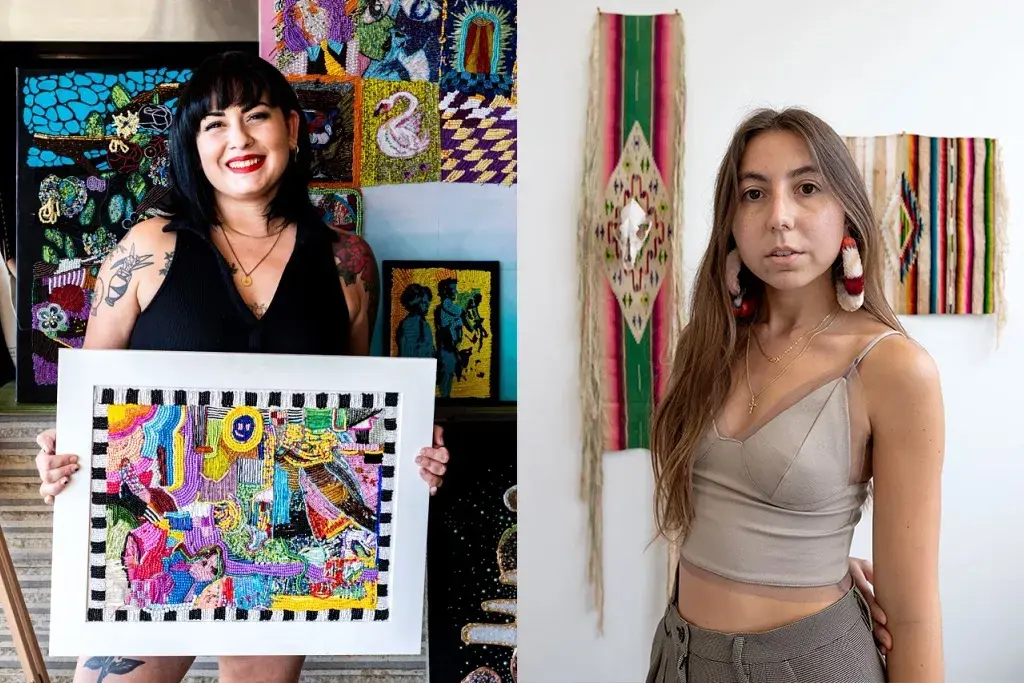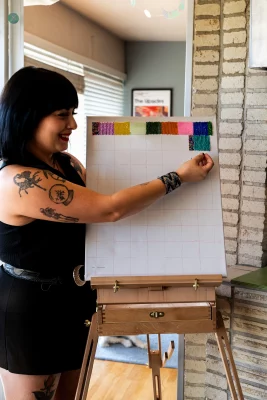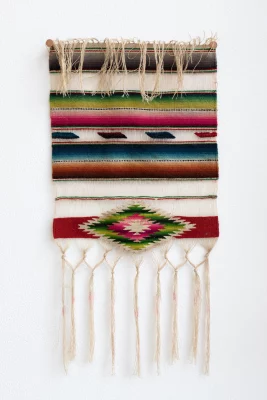
I Exist Because They Survived: Artists Unpack Assimilation at Material Gallery
Art
For artist Bianca Velasquez, reconnecting with her ancestors through art was a journey that began by accident. Rather than throw away the canvas she tore while painting, Velasquez began to repair it with a needle, thread and beads. “It just grew, and I filled the entire canvas with beading,” she says.
Despite creating art her whole life, this was the start of something new. After her family immigrated to the U.S. from Honduras, much of their history and tradition was left behind under pressure to assimilate. Even though the beadwork was deeply reminiscent of the traditional artwork made by her ancestors, Velasquez still felt distanced from the form.

“I [felt] kind of unethical for using such a traditional medium because I haven’t done the work to connect with my lineage and my ancestry. As a product of assimilation … I felt like I was appropriating my own culture by beading, which is such a crazy concept that I’m still unpacking,” she says.
“I started dismantling them and taking them apart, and it originally was an act of mourning, but it turned into an act of reclamation.”
It wasn’t until a conversation with Jorge Rojas, local artist and co-founder of new South Salt Lake art gallery Material, that Velasquez began to consider beadwork as a pathway for reconnection. Rojas describes her work as “primal,” a word that resonates with Velasquez. “I’m connecting to something spiritual that is healing me and healing generational trauma that goes back and back and back,” she says.
When Rojas joined forces with multidisciplinary art collective 801 Salon for a new installation, Velasquez’s beadwork was an obvious choice, and when considering the theme of what it means to assimilate—especially from a Latinx perspective—artist Kelly Tapìa-Chuning came to mind.
Tapìa-Chuning has been making art that explores her personal and familial history for much of her life. After her great-grandmother’s passing in 2021, she began recording her family’s history, uncovering the lost pieces of her lineage. As a mixed-race Chicana with Indigenous ancestry, Tapìa-Chuning shares a similar experience of losing familial identity to colonization.
“My family is very much assimilated,” Tapìa-Chuning says. “I didn’t grow up within a proud Mexican family … being mixed-race myself, it felt like two opposing forces. I always had a hard time accepting my identity.” This feeling, she explains, is exacerbated by the fact that much of the Indigenous history and culture in the U.S. has been made inaccessible by mainstream, racist ideology that deems it unimportant.
“I’m connecting to something spiritual that is healing me and healing generational trauma that goes back and back and back.”

The desire to uncover her family’s history and unpack what it means to assimilate led Tapìa-Chuning to examine the Mexican blanket, an object she grew up around that served as an anchor within her household. The history of the blanket itself is symbolic of what it is to be mestiza, created with both Indigenous and European traditions. Tapìa-Chuning relays that it was also used by the Mexican government after the Mexican Revolutionary War to perpetuate a homogenous Mexican identity, one that erased Afro and Indigenous cultures.
“I started dismantling them and taking them apart, and it originally was an act of mourning, but it turned into an act of reclamation. What does it mean for me, as a mixed-race woman of Indigenous descent, to be putting my labor into these blankets?” she says.
Sharing a space for the upcoming installation at Material gallery has been a source of inspiration for both artists, and a chance to see themselves through each other’s work. “While we have different mediums … a lot of what we’re trying to dissect is coming from the same place,” Velasquez says of their collaboration. Tapìa-Chuning smiles and adds, ‘‘The first time we connected, it felt like our souls connected.”
The exhibit is titled Sangre Mía, or “My Blood.” Summed up into a sentence, Tapìa-Chuning describes a central motif of the installation: “I exist because they survived.” Sangre Mía opens Nov. 11 with an artist talk at 5 p.m. and general admission at 6 p.m. at Material, located at 2970 South West Temple. Keep up with the artists on Instagram @biancavelasquez.tv and @kelly_chuning.
Read more art features here:
Encircle Gallery: Art for the Community, by the Community
Illustrating the Inbetween: Mel Aphayrath